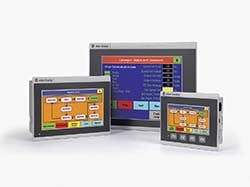Rockwell Automation Introduces PanelView 800 Graphic Terminals
Rockwell Automation introduces the space-saving Allen-Bradley PanelView 800 family of graphic terminals, available in 4-inch, 7-inch and 10-inch display sizes. The terminals feature an 800 MHz CPU processor, up to 256 MB of flash and dynamic memory to reduce boot-up time, making them two times faster than the previous PanelView Component terminals. The terminals also offer improved touchscreen responsiveness and can be configured in portrait and standard landscape mode for greater installation flexibility.
The PanelView 800 graphic terminals are specifically designed for use with the Allen Bradley Micro800 and MicroLogix control systems. The terminals’ high-resolution screens with LED backlights can display up to 65,536 colors. Built-in Ethernet and serial communications ports (RS232, RS422 and RS485) support easier controller connectivity, while USB and microSD ports make file transfers easier. The terminals are also certified for Class 1, Division 2 hazardous locations.
The Connected Components Workbench software Release 8.0, which includes support for the PanelView 800 graphic terminals, gives machine builders a common environment to program the Micro800 controllers, as well as to configure the Allen-Bradley PowerFlex drives and Allen-Bradley Guardmaster safety relays. Release 8.0 includes support for the Guardmaster 440C-CR30 safety relay Ethernet plug-in for communications to Micro800 and Allen-Bradley CompactLogix controllers; the Micro800 high-speed counter plug-in feedback axis to ease motion programming; and Micro800 DeviceNet scanner plug-in diagnostics to ease troubleshooting DeviceNet-connected devices.
The developer edition includes an archive manager to track the project with a timestamp and description. The developer edition also offers an enhanced Micro800 programming experience, with intellectual property protection, user-defined data types, a spy list to monitor variables easier, and the ability to make program logic changes while in run mode.
.




